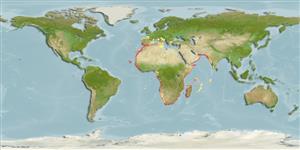Classification / Names
Common names from other countries
Main reference
Size / Weight / Age
Max length : 80.0 cm TL male/unsexed; (Ref. 30573); common length : 40.0 cm TL male/unsexed; (Ref. 3593)
Environment
Marine; demersal; depth range 50 - 300 m (Ref. 4780), usually 150 - 200 m (Ref. 26999)
Climate / Range
Subtropical; 14°C - 15°C (Ref. 27121), preferred 26°C (Ref. 107945); 50°N - 28°S
Distribution
Eastern Atlantic: Bay of Biscay to South Africa (Ref. 4373), including the western Mediterranean. Western Indian Ocean: east coast of Africa (Ref. 3490); probably also in the Arabian Sea under synonyms capensis (non Pappe ?), sinuata Day and striata Boulenger.
Countries | FAO areas | Ecosystems | Occurrences | Introductions
Short description
IUCN Red List Status (Ref. 115185)
Threat to humans
Harmless
Human uses
Fisheries: commercial
More information
ReferencesAquacultureAquaculture profileStrainsGeneticsAllele frequenciesHeritabilityDiseasesProcessingMass conversion
Tools
Special reports
Download XML
Internet sources
Estimates of some properties based on models
Phylogenetic diversity index
PD50 = 0.5000 many relatives (e.g. carps) 0.5 - 2.0 few relatives (e.g. lungfishes)
Trophic Level
3.4 ±0.44 se; Based on food items.
Resilience
Medium, minimum population doubling time 1.4 - 4.4 years (K=0.26)
Vulnerability
Moderate vulnerability (44 of 100)
Price category
